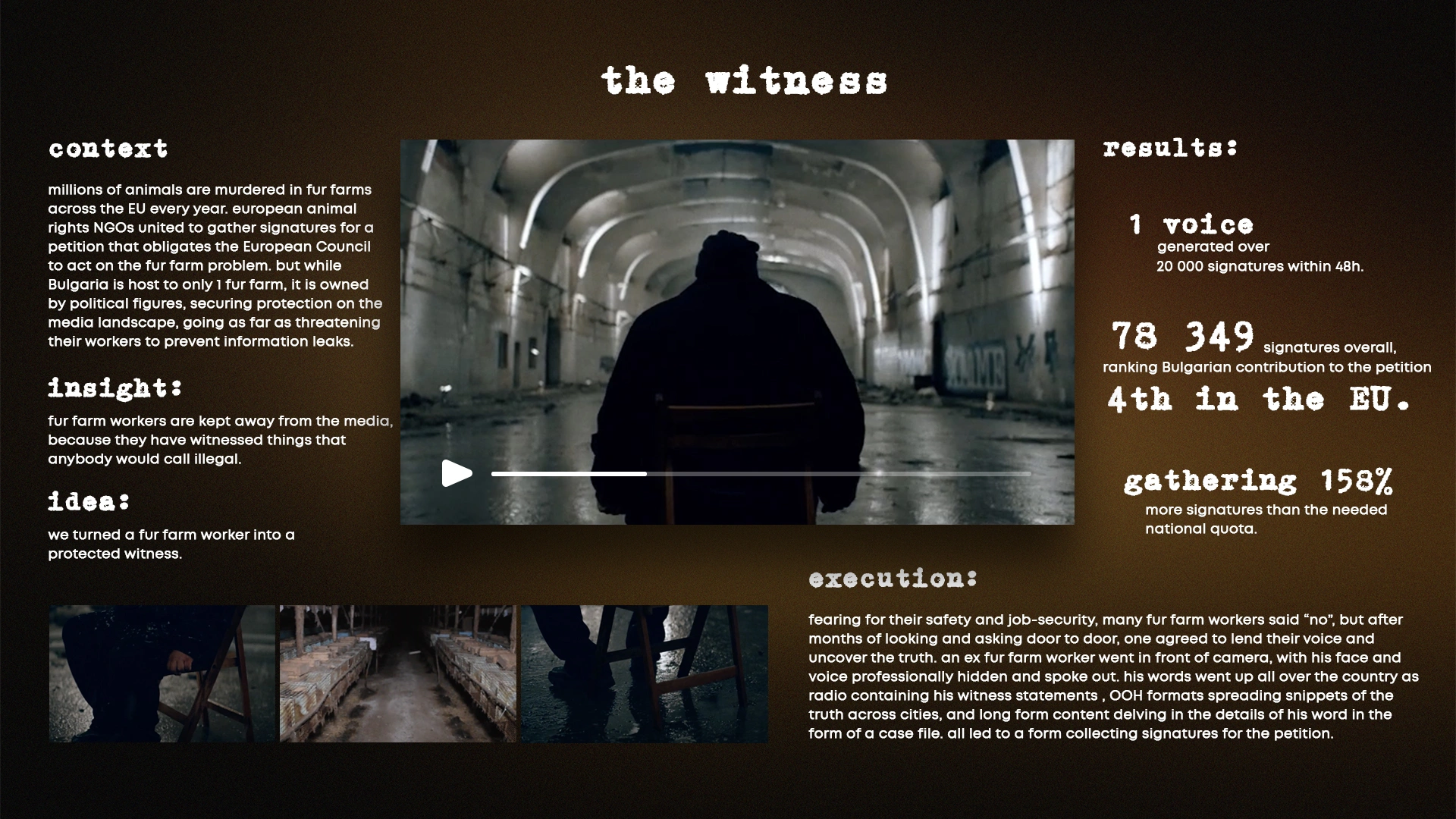Кейс
The Witness

- Бренд
- Invisible Animals
- Агентство
For years, mink have been bred in European fur farms for a single purpose—to be turned into fashion coats and accessories. These animals are not used for food; they are born and die in the farms. In Bulgaria, over 130,000 mink are raised in a single farm in Madjerito, according to the Bulgarian Food Safety Agency (BFSA). In March 2024, the European Commission registered the "Fur Free Europe" initiative, aiming to ban fur farming. To move forward, the campaign needed to collect 1,000,000 valid signatures across the EU within a year. Bulgaria's target was 11,985 signatures. The Bulgarian organization "Invisible Animals", along with "Kaji" and Four Paws, joined the campaign. Each organization had an independent platform for signature collection, ensuring compliance with EU regulations. The Bulgarian public is largely unaware of the issue. Media coverage is minimal, overshadowed by geopolitical and political crises. The main challenges for "Invisible Animals" stemmed from a lack of awareness: Fur farming is not widely discussed. With only one farm in Bulgaria, the issue rarely enters public discourse. The organization is new. Founded in late 2021, "Invisible Animals" risked being dismissed as “just another group trying to fix the world.” Public skepticism was high. Asking people to share personal data for an online petition about an unknown issue was a significant barrier. The campaign needed to reach an audience likely to care—animal lovers. These included pet owners, their friends, and people with empathy for animals, even if they didn’t have pets.
Проблема
To bring attention to the issue, we looked for visible signs of trouble. Job postings from FARMPRO, the owner of the Madjerito fur farm, appeared frequently—indicating high staff turnover. We confirmed this by analyzing local job ads and speaking with locals. Workers described the job as unbearable, hinting at illegal or unethical practices.
Решение
The challenge was clear: fur farming in Bulgaria was practically invisible. With only one farm in the country, no public debate, and a new NGO with little recognition, convincing people to share their personal data to sign an EU petition seemed nearly impossible. To break through, we needed an authentic, credible voice — one that no one could ignore.
After six months of groundwork, “Invisible Animals” found a former worker willing to testify about the brutal conditions inside the Madjerito mink farm. His story became the foundation of the campaign. Disguised for his safety, his distorted voice told a chilling truth: “This is a cruel job.”
Instead of showing shocking images of suffering animals — a tactic people often turn away from — we humanized the problem through the words of someone who had lived it. His testimony became the centerpiece of an online video, radio spots, posters, city lights, social media content, and a printed “witness dossier” distributed in pet-related spaces.
By turning a hidden worker into a witness — and ultimately into an “influencer” — the campaign built trust, sparked empathy, and mobilized action. What was once invisible suddenly became undeniable, leading to tens of thousands of signatures and massive awareness.
Результаты
To build credibility, we needed an insider’s perspective. After six months, we found someone brave enough to share their experience anonymously. We conducted an anonymous witness interview, disguising their voice and identity. Their shocking testimony became the foundation of a viral campaign: Online video with the witness’s distorted voice Posters, billboards, and city lights Radio spots Social media content A full "witness dossier" The campaign carried the chilling tagline: “This is a cruel job.” Followed by the call to action: “Sign to end mink farms in Europe.” The farm's owners were powerful, and their control included mandatory polygraph tests for workers every two months. Ensuring the witness’s safety was crucial. By leveraging their testimony across different media, we made an invisible problem visible. Channel used We kicked off the campaign with an online video, which we published to our small but engaged social media audience on Facebook and Instagram (just over 800 followers before the campaign launch). We asked them to share the video, turning those who already knew us into trust ambassadors for the cause. At the same time, we collaborated with 10 influencers—pet owners—to give the campaign an extra push in its first few days. Additionally, the video was targeted at our social media audience and their friends using funds received through Google Grants. After initiating conversations and building trust in the organization and its cause, we reinforced our message through: PR articles and media appearances Radio spots, transforming the witness’s words into impactful audio messages Posters and city lights, strategically placed near parks where people walk their pets We also created a "witness dossier"—an 8-page magazine-style publication—which was distributed in veterinary clinics, pet grooming salons, pet hotels, and other places where people either wait or spend time, often with an interest in animals. These locations provided the perfect setting for consuming long-form content.
